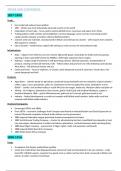TRADE AND COMMERCE
1857-1890:
Trade:
Free trade had replaced mercantilism
1857 – Britain was most industrially advanced country in the world
Imperialism of free trade – force used to enforce British terms, royal navy and opium from China
Trading patterns with colonies well-established, common language, same currency, borrowing London
capital markets cheaper as lenders relied on British positions
Colonies send raw materials, manufactured in Britain and sold back to colonies – 20% imports form colonies,
30% exports to colonies
City of London = world finance capital with sterling as main currency for international trade
Infrastructure:
Ships – clippers from 1843 to carry low-volume high profit goods, steamships for bulky and heavy goods,
opening of Suez Canal 1869 shorter by 9000km, 1870 triple expansion steam engine
Railways – largest single investment in self-governing colonies, allowed expansion, transportation of
produce, moving commercial interests, India – linked cotton and jute farms to mills in Bombay and Calcutta,
West Africa – link between interior and sea
Canals and rivers – focus of explorers, in Canada canals deepened around St Lawrence/ Great Lakes, Inia –
canals deepened and built
Products:
Agriculture – colonies based on agriculture, produced cheap foodstuffs and raw materials, tropical colonies –
coffee, sugar, cocoa, groundnuts, palm oil, subsistence farmers accepted low prices, plantations run by
British – ‘coolies’ sent to West Indies or south Africa for low wages, Indian tea, Malayan rubber and palm oil
Mining – tin in Nigeria, diamonds in Sierra Leone, gold in Gold Coast and Southern Rhodesia, copper in
Northern Rhodesia, 1886 – gold in Witwatersrand, gold-rush to Transvaal, gold also found in Aus
Industry – limited development as could not compete with British world markets, Indian mills could not
compete with British textile industry
Chartered Companies:
Encouraged 1850s and 1860s
From 1870s – economic challenges from European and American industrialisation and Great Depression so
revived Chartered companies to boost trade without cost to government
1884 Imperial Federation League promoted chartered companies for Empire
1881 North Borneo Trading Company – charter for administering territory, benefitted from deposits of coal,
iron and copper, development of coffee and tobacco plantations, mid point between India and Hong Kong
1886 Royal Niger Company – government in Niger region, trade and expansion northwards
1888 Imperial British East Africa Company
1889 British South Africa Company
1890-1914:
Trade:
Acceptance that Empire made Britain wealthy
Under free trade Britain had disproportionate amount of trade and investment in its own colonies – India
took 20% of British exports, exported raw goods such as cotton and tea back, both consumed in Britain and
sold on to other countries from Britain
, Other colonies helped clothe and feed Britons – wool and sugar from South Africa and Australia, dairy
produce and lamb from New Zealand, beef and wheat from Canada, timber, cocoa, rubber, peanuts and
palm oil from West Africa
Imperial Federation League disbanded in 1893- waning interest in commercial importance of Empire
Growing trade with USA
Empire provided less than 10% of foodstuffs to Britain
Expanding empire but static trade levels
Anti-imperialists argued Empire cost more than it gave, limited British modernisation and better conditions
for workers, behind in chemical and electrical engineering – Britain relied on rubber imports from Africa and
Asia but Russia, France and Germany had started synthetic rubber production by 1910
Investment in Empire:
British investment doubled from £2 million to £4 million between 1900 and 1913 but not all with Empire
Loans with foreign nations gave bigger returns
Loans with Empire developed rival manufactures to Britain e.g. cotton mills in India – dangerous to British
industry
London remained finance capital – shares sold for ventures in minerals, tobacco, timber and transport
Colonial Loans and Colonial Stocks Acts of 1899 and 1900 facilitated infrastructure projects of railways into
interior of Africa
Encouraged other countries to adopt gold standard, by 1908 only China, Persia and some Central American
countries used silver standard
Debates over Trade with Empire:
Pro imperialist Josheph Chamberlain – Colonial Secretary (1895-1903), convened 1902 London Colonial
Conference to discuss creating stronger economic ties with self-governing colonies with imperial customs
union, would have boosted imperial trade with protective tariffs, believed imperial trade was better as
reliable in times of emergency and imperial preference would see potential for higher productivity
recognised
Resistance from manufacturing, shipping and banking industries – free trade preferred
1906 General Election rejected imperial preference as it would have upped food prices, voting for Liberal’s
commitment to free trade
Before 1914 Aus, NZ and South Africa imposed import tariffs to assert national interest over loyalties to
Britain
Canada – separate trading agreements with Germany, France, Italy and Japan, with commercial unity was
America as a potential
India – British textiles and goods boycotted and burned as swadeshi movement begun from 1905
1914-1947:
Economic Impact of WW1:
Expensive – overseas investments wiped out; pound sterling removed from gold standard
Productions for war supplies prioritised, other nations took over British markets e.g. Japanese textile
industry
1930’s great depression – collapse in international trade, gold standard cut off in 1931 financial crisis
India – contributed £146 million, experienced shortages and inflation, Indian manufacturers captured more
domestic market, British placed high taxes on Indian imports after war (1917=11%, 1931=25%) to give Indian
industry protection from competitors
Canada – emerged as industrial power, looked to USA for investments and markets
Aus/NZ – relied on British market as exporters of food, hit hard by war
Trade and Commerce between the Wars:




